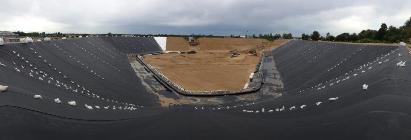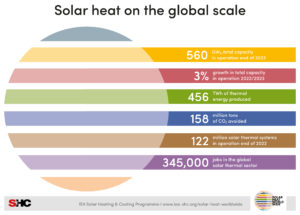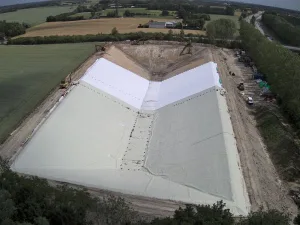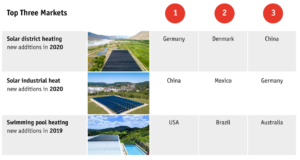Germany/Denmark: Geosynthetic Lining for Large-Scale Underground Heat Storage Tank
October 27, 2014
Dronninglund, Vojens and Gram are three Danish solar district heating plants whose underground heat storage has been lined with a new type of improved polymeric geomembrane. This membrane, which was developed and is produced in Germany by GSE Environmental, can withstand peak temperatures of up to 95°C and has an expected lifetime of at least 20 years. Headquartered in Houston, Texas, GSE Environmental is a manufacturer of geosynthetics –materials that ensure the durability of state-of-the-art lining solutions for various applications, such as in landfills, mining, water and waste water treatment, as well as in the oil, gas and energy sector. The photo shows the Vojens installation, a 203,000 m³ storage system which should come into operation next year.
Photo: GSE Environmental

The demand for – and the research in – high-temperature-resistant polymeric geomembranes dates back to the early 1980s. One of the first ideas related to renewable energy was to use these membranes for solar-pond heat storage, whose horizontal layers of water have different brine concentrations, in order to capture and store solar thermal energy at very low cost. Particularly in light of the anticipated growing needs for cost-efficient heat storage solutions, development started about 10 years ago,” says Stefan Baldauf, Director of Global Sales Engineering at GSE. For example, the Danish Technological Institute (DTI) developed a special long-term testing method to adequately simulate the in situ conditions and prove the durability of the geomembrane.
GSE has more than 40 years of experience in manufacturing geosynthetics used for landfills and in the water and mining industry. In Vojens and Gram, GSE provides the complete package, including the geosynthetic lining material and ballast pipes, and the company is also responsible for installing the liner on site. According to GSE, the large-scale pit heat storage design has the potential to reduce costs by up to 80 % per m³ compared to an insulated steel tank above ground.
Special solar requirements: Easy to weld but stable at high temperatures
“We developed a special polymer stabiliser formulation that allows processing and welding as with any other polymer lining,” Baldauf says. The welding process is either a so-called hot-wedge welding at about 350 °C or an extrusion welding at around 220 °C. According to Baldauf, GSE employs these welding techniques in compliance with the German Welding Society guidelines on landfill applications, which require a 100-year durability of the liquid containment system.
A typical roll with 100 m of 2.5 mm thick liner for solar applications is 7.5 m wide, 0.6 m in diameter and weighs around 1.5 tons. Placing and handling the geomembrane in the pit requires a spreader bar – a kind of giant paper-towel holder carried, e.g., by an excavator.
Floating cover includes insulation
The second important element specially developed for the large-scale heat storage systems is the floating cover with an insulation layer, sandwiched between two layers of geomembrane. Whereas simple floating covers are known from other applications in the chemical or agricultural industry, or form drinking water reservoirs, insulated floating covers represent a new development. GSE has not revealed much about the insulation material, but the company says that enhancements are being made from one project to the next. “The cover is one of the highest cost factors in setting up the storage, which means there is a lot of interest in reducing the costs,” Baldauf says.
There are two methods to mount the floating cover: The first one is to draw the cover on pontoons over the already filled storage, a method which was used in Dronninglund and Marstal, both projects equipped with geomembrane from GSE.
The other option is to install the initial cover layer in the already lined but not yet filled pit. When the water is added, it flows between the lining and the cover, lifting the cover while pouring in. This method will be used in Vojens and Gram. “Obviously, it is easier to work on dry ground than on water,” Baldauf says. Still, putting several thousand square metres of floating liner in the right place is, of course, something that requires special knowledge and machinery.
Larger seasonal heat storage possible
In Vojens, the storage size will be about 203,000 m³ and in Gram about 110,000 m³. But according to GSE, even larger projects with 500,000 m³ are possible and have already been under discussion. Currently, the usual depth of these reservoirs is 14 to 16 m, but larger storage volumes may require the construction of even deeper reservoirs in order to limit land use.
GSE’s total annual production capacity in Germany is large enough to line some 20 million m2. “Of course, today, solar has only a small share, but I would certainly not call it a niche market – much rather an emerging, innovative application with significant growth potential,” Baldauf adds.
More information:
GSE Environmental: http://www.gseworld.com
Marstal District Heating: http://www.solarmarstal.dk/
Dronninglund District Heating (Danish only) http://www.drlund-fjernvarme.dk/
Vojens District Heating (Danish only) http://www.vojensfjernvarme.dk/
Gram District Heating (Danish only) http://www.gram-fjernvarme.dk


